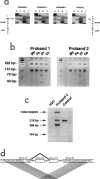Abstract
Mutations in the gene encoding fibrillin-1 (FBN1), a component of the extracellular microfibril, cause the Marfan syndrome (MFS). This statement is supported by the observations that the classic Marfan phenotype cosegregates with intragenic and/or flanking marker alleles in all families tested and that a significant number of FBN1 mutations have been identified in affected individuals. We have now devised a method to screen the entire coding sequence and flanking splice junctions of FBN1. On completion for a panel of nine probands with classic MFS, six new mutations were identified that accounted for disease in seven (78%) of nine patients. Nine additional new mutations have been characterized in the early stages of a larger screening project. These 15 mutations were equally distributed throughout the gene and, with one exception, were specific to single families. One-third of mutations created premature termination codons, and 6 of 15 substituted residues with putative significance for calcium binding to epidermal growth factor (EGF)-like domains. Mutations causing severe and rapidly progressive disease that presents in the neonatal period can occur in a larger region of the gene than previously demonstrated, and the nature of the mutation is as important a determinant as its location, in predisposing to this phenotype.
Full text
PDF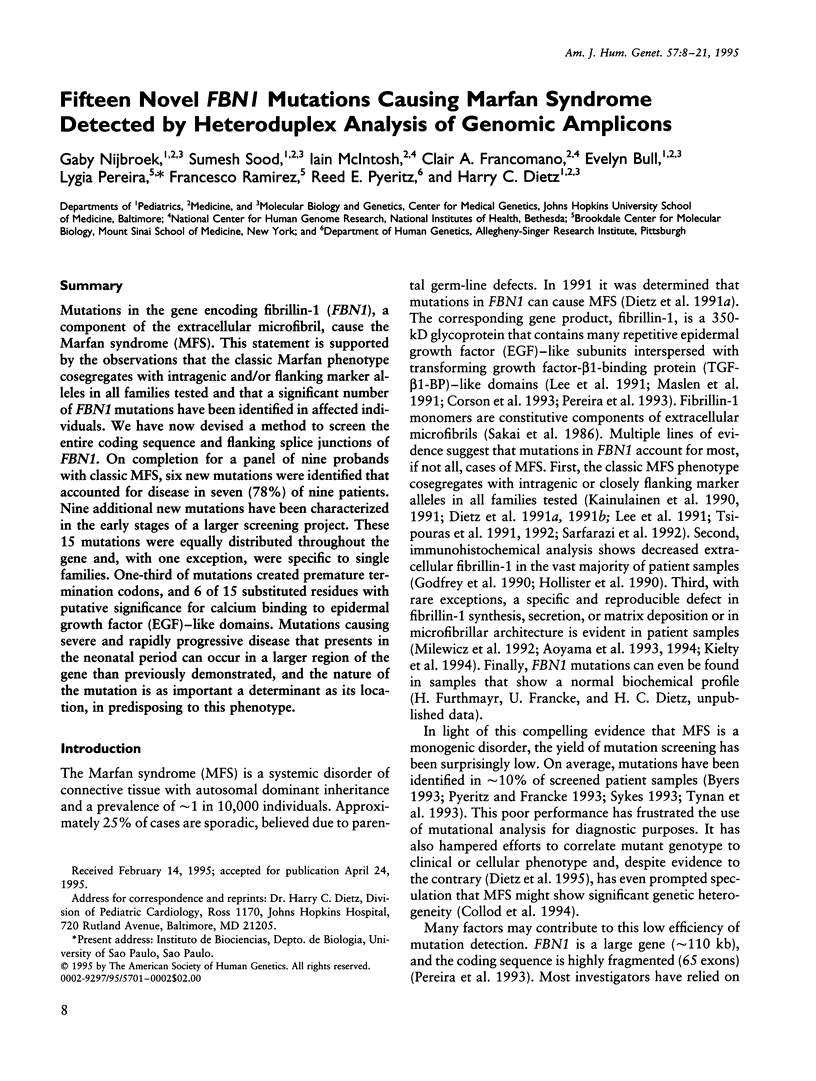
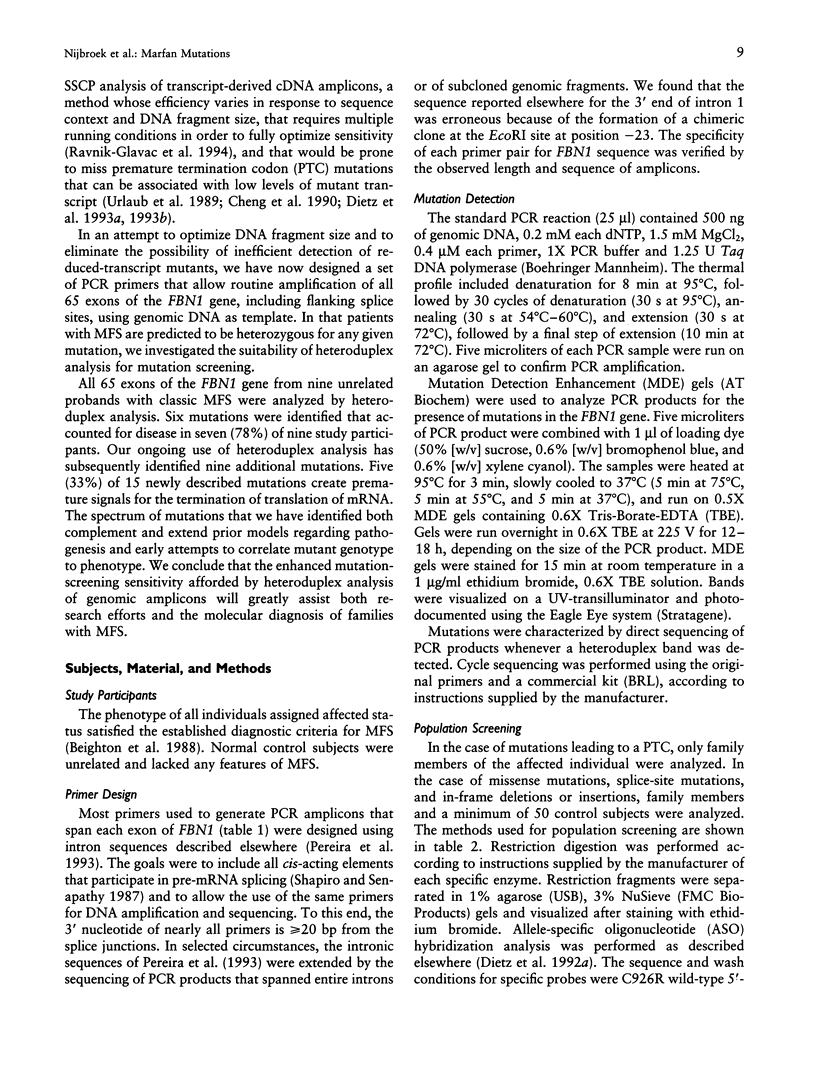
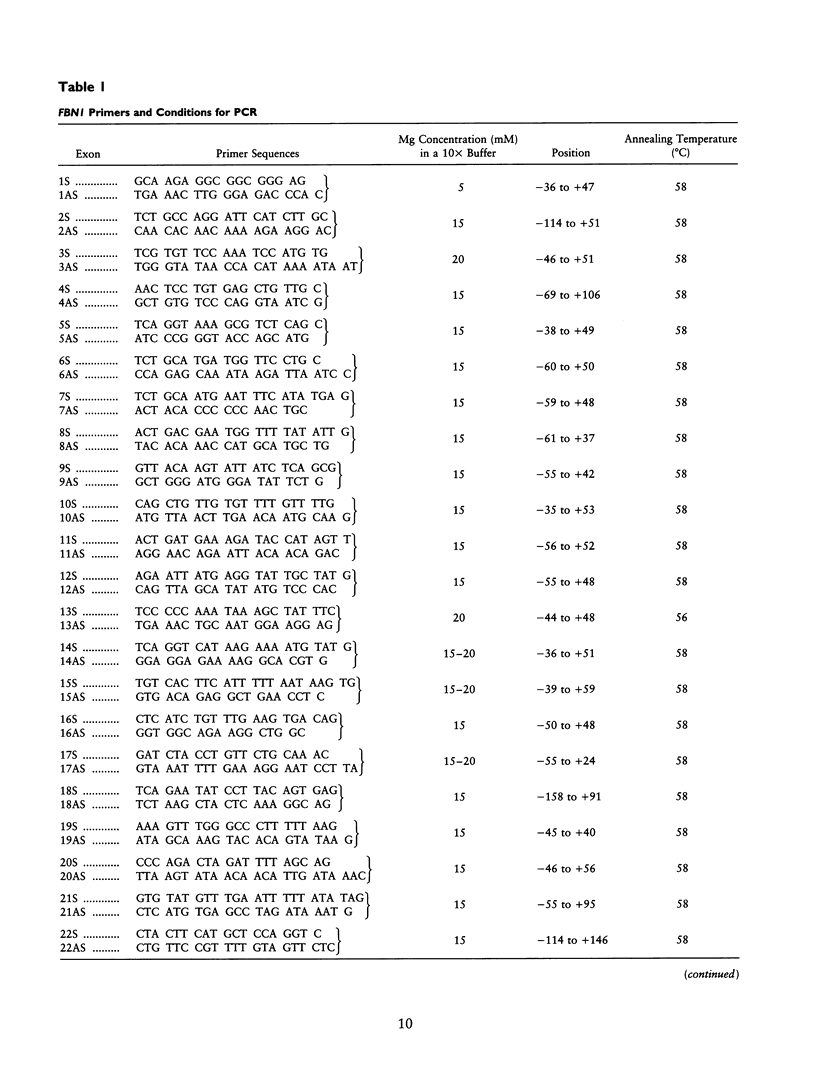
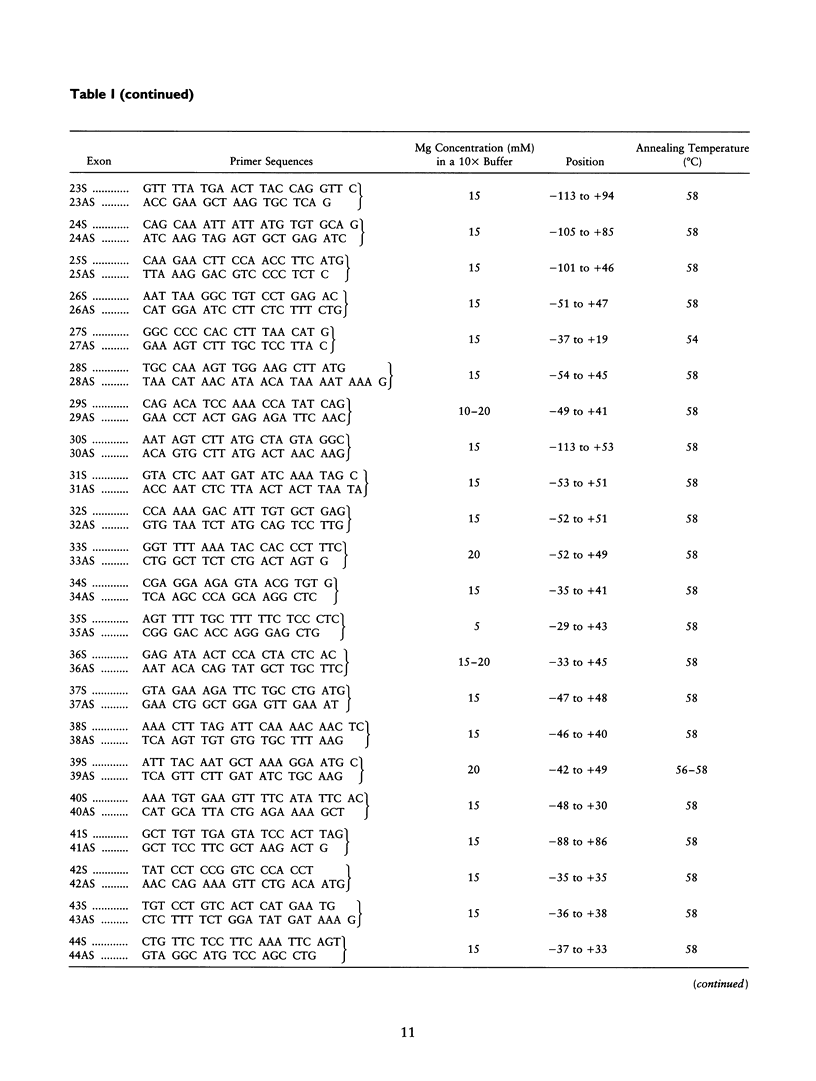
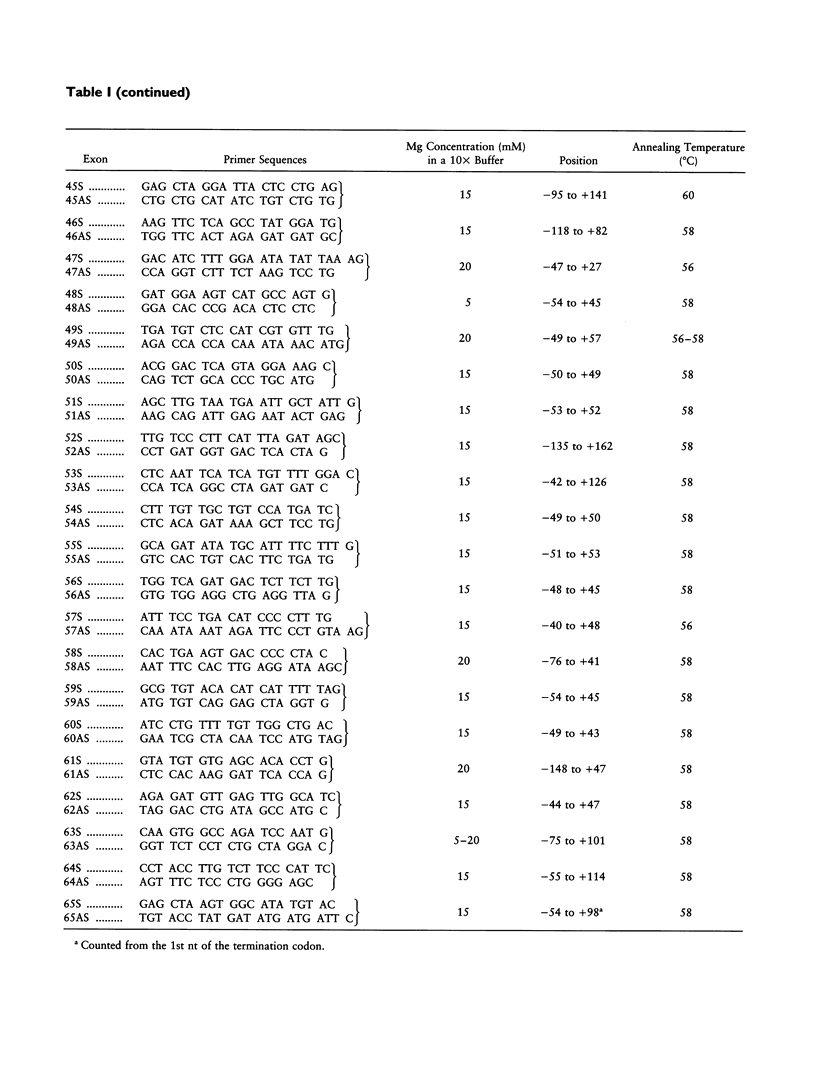
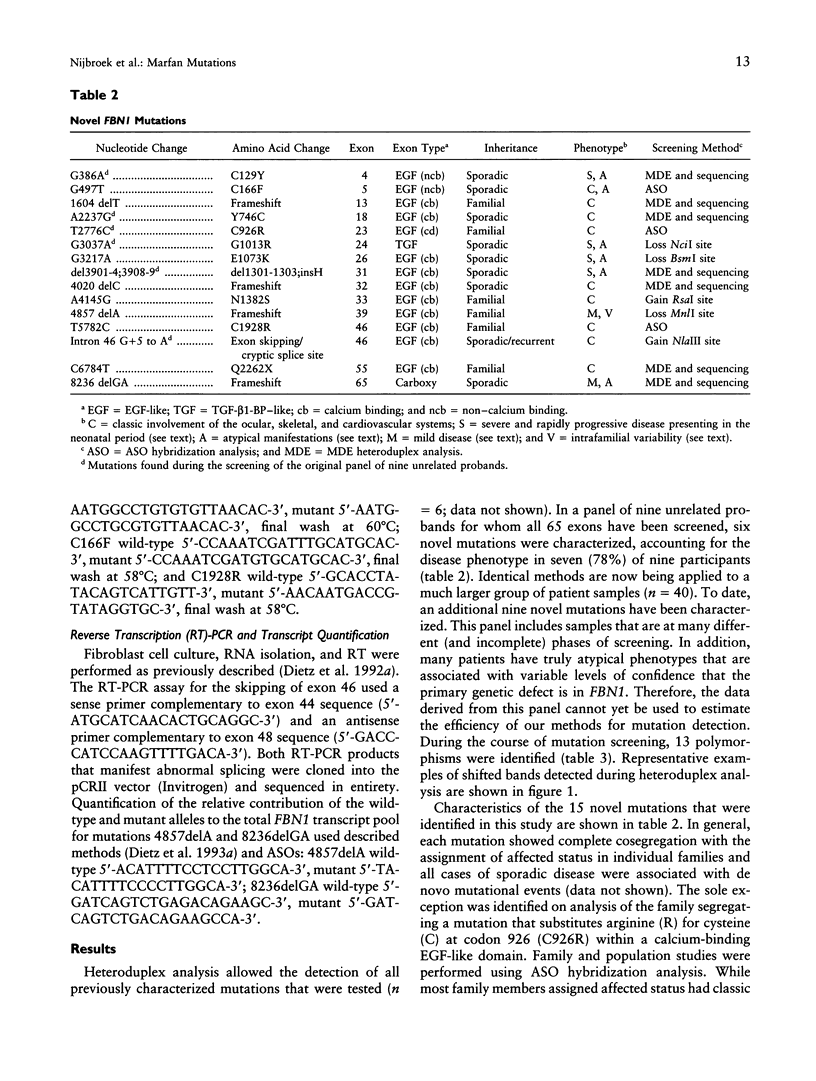
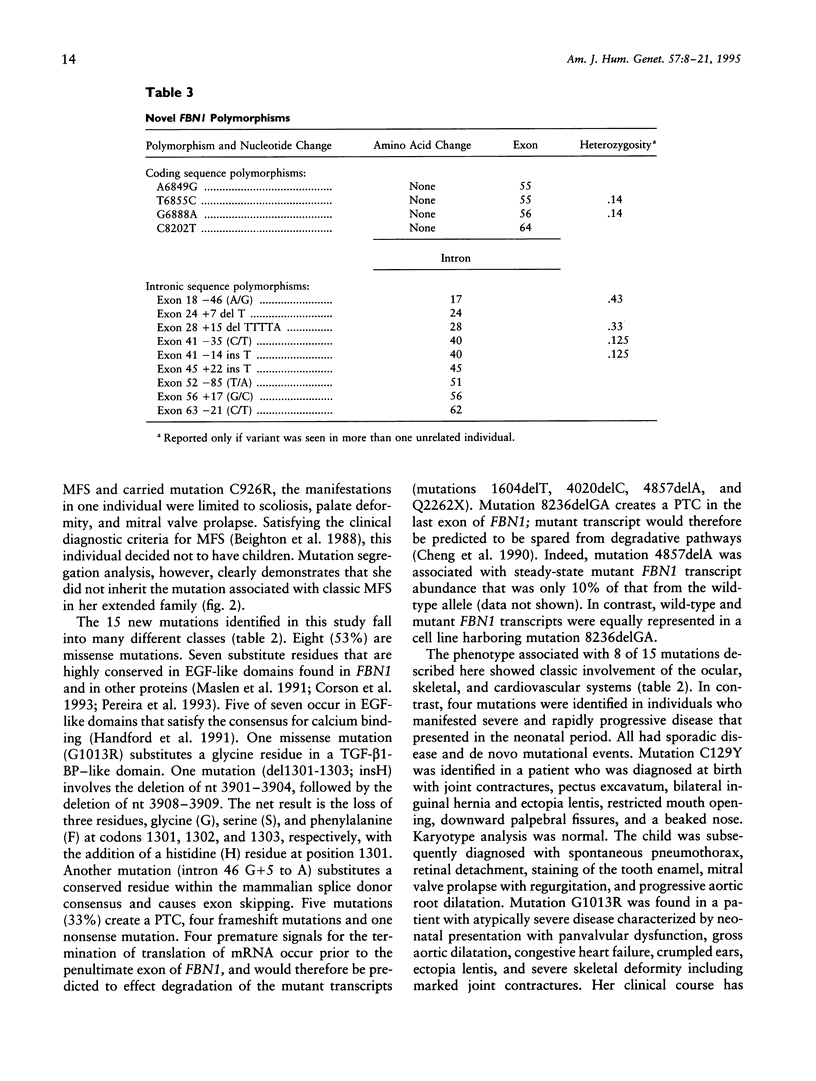
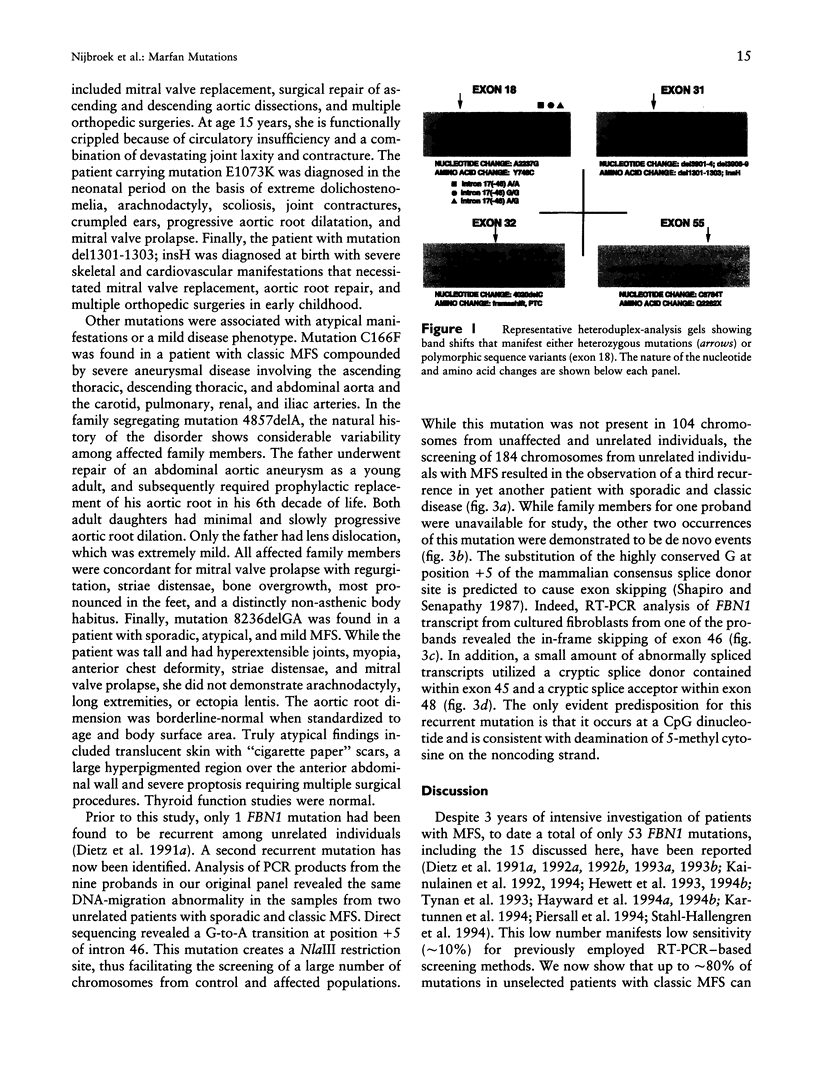
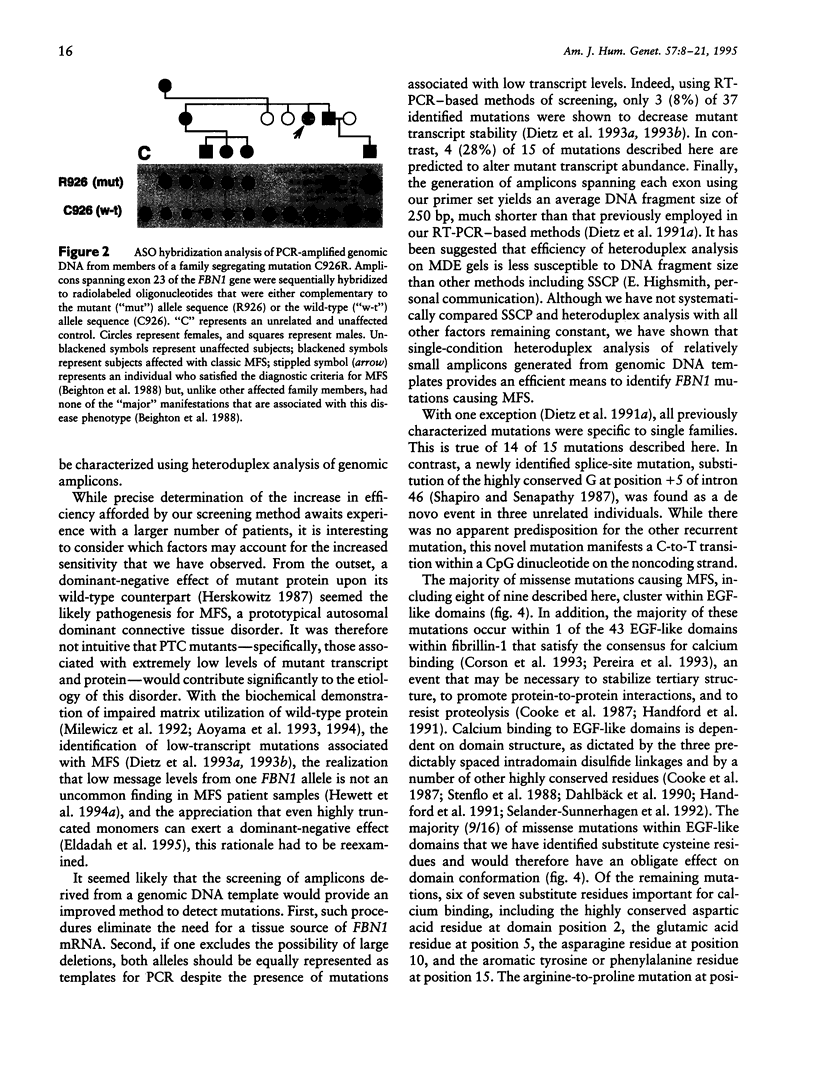
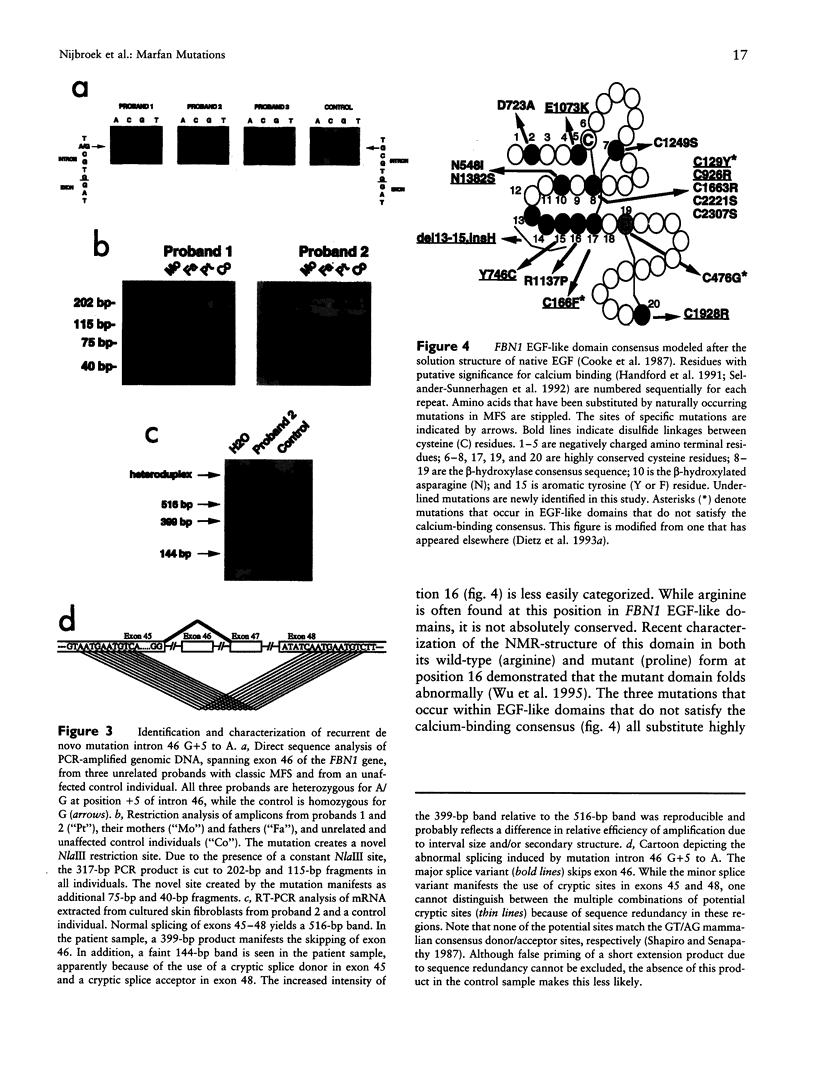
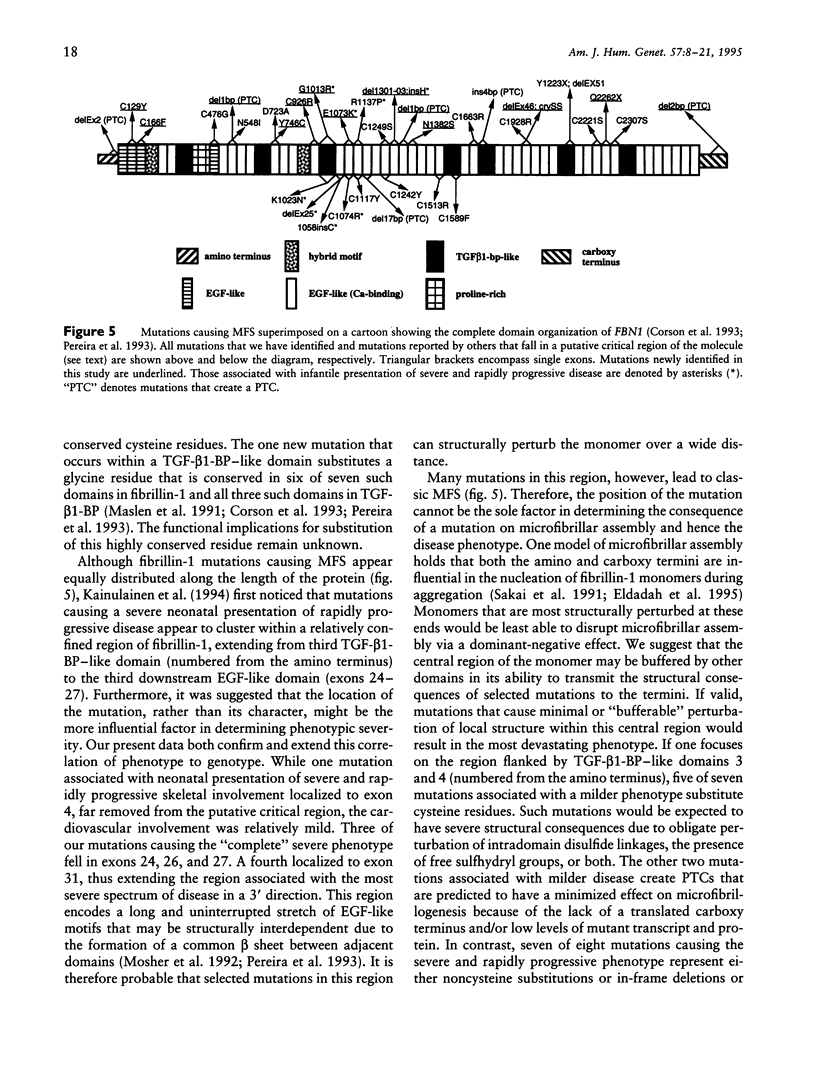
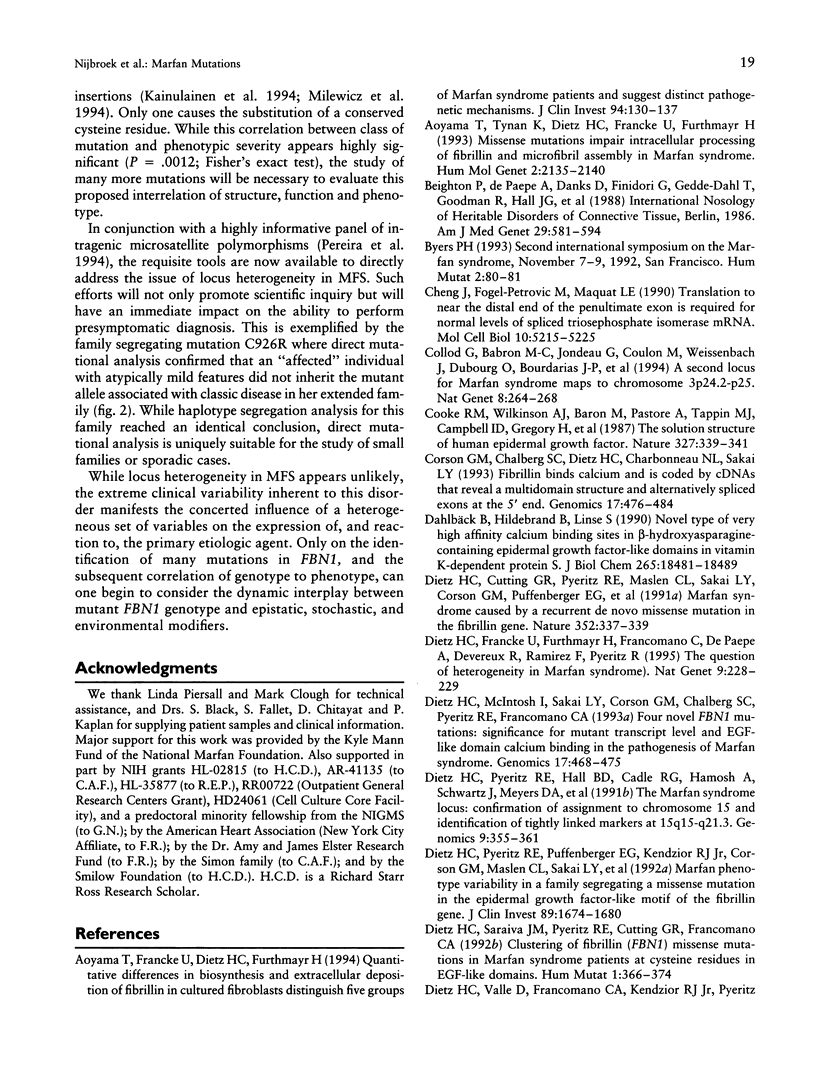
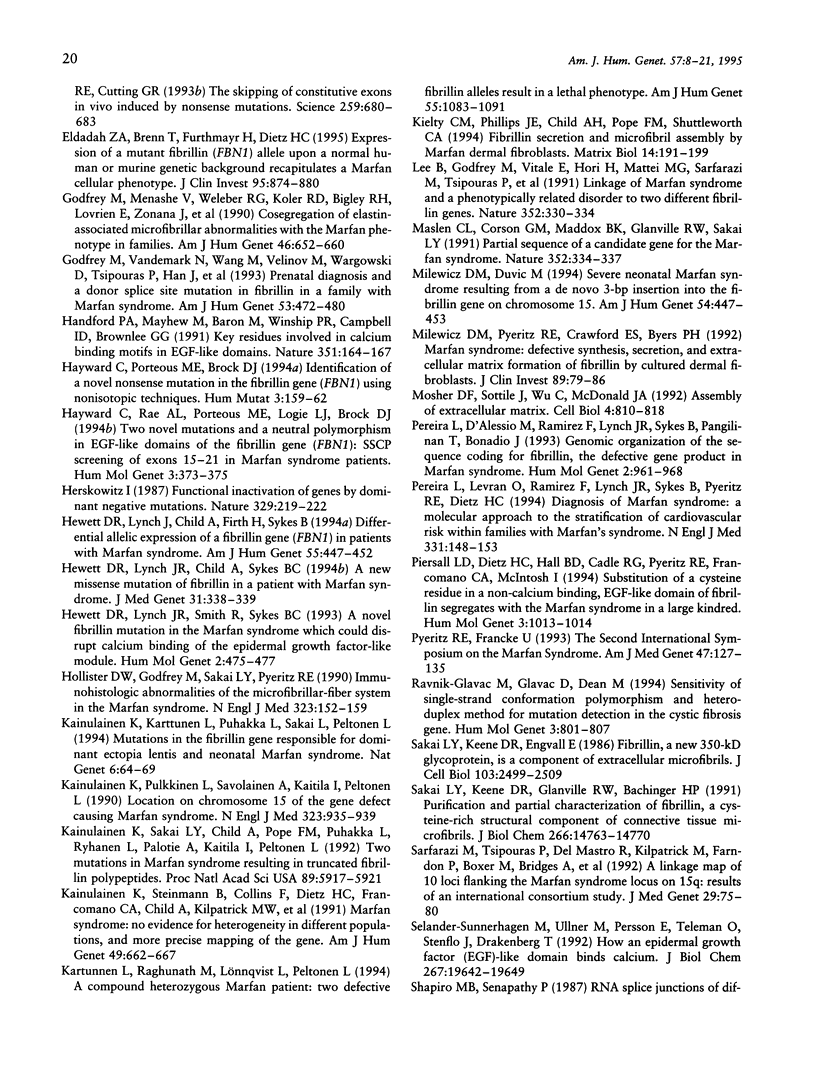
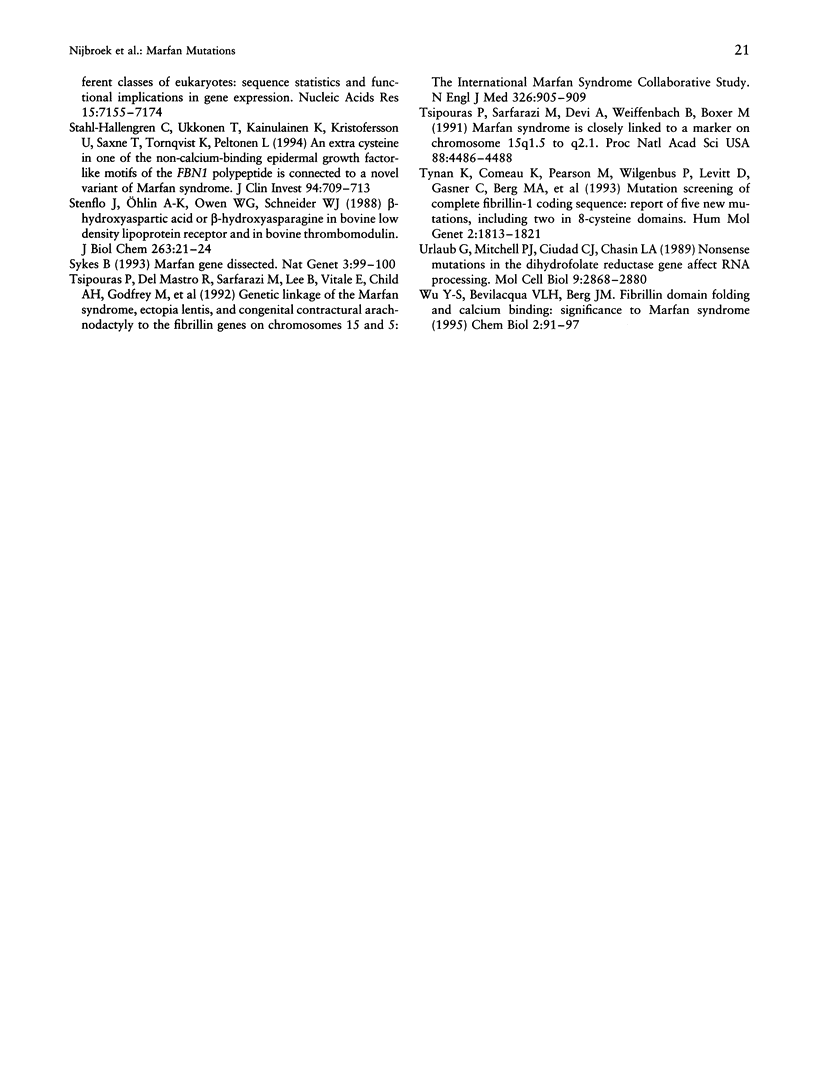
Images in this article
Selected References
These references are in PubMed. This may not be the complete list of references from this article.
- Aoyama T., Francke U., Dietz H. C., Furthmayr H. Quantitative differences in biosynthesis and extracellular deposition of fibrillin in cultured fibroblasts distinguish five groups of Marfan syndrome patients and suggest distinct pathogenetic mechanisms. J Clin Invest. 1994 Jul;94(1):130–137. doi: 10.1172/JCI117298. [DOI] [PMC free article] [PubMed] [Google Scholar]
- Aoyama T., Tynan K., Dietz H. C., Francke U., Furthmayr H. Missense mutations impair intracellular processing of fibrillin and microfibril assembly in Marfan syndrome. Hum Mol Genet. 1993 Dec;2(12):2135–2140. doi: 10.1093/hmg/2.12.2135. [DOI] [PubMed] [Google Scholar]
- Beighton P., de Paepe A., Danks D., Finidori G., Gedde-Dahl T., Goodman R., Hall J. G., Hollister D. W., Horton W., McKusick V. A. International Nosology of Heritable Disorders of Connective Tissue, Berlin, 1986. Am J Med Genet. 1988 Mar;29(3):581–594. doi: 10.1002/ajmg.1320290316. [DOI] [PubMed] [Google Scholar]
- Byers P. H. Second international symposium on the Marfan syndrome, November 7-9, 1992, San Francisco, CA. Hum Mutat. 1993;2(2):80–81. doi: 10.1002/humu.1380020203. [DOI] [PubMed] [Google Scholar]
- Cheng J., Fogel-Petrovic M., Maquat L. E. Translation to near the distal end of the penultimate exon is required for normal levels of spliced triosephosphate isomerase mRNA. Mol Cell Biol. 1990 Oct;10(10):5215–5225. doi: 10.1128/mcb.10.10.5215. [DOI] [PMC free article] [PubMed] [Google Scholar]
- Collod G., Babron M. C., Jondeau G., Coulon M., Weissenbach J., Dubourg O., Bourdarias J. P., Bonaïti-Pellié C., Junien C., Boileau C. A second locus for Marfan syndrome maps to chromosome 3p24.2-p25. Nat Genet. 1994 Nov;8(3):264–268. doi: 10.1038/ng1194-264. [DOI] [PMC free article] [PubMed] [Google Scholar]
- Cooke R. M., Wilkinson A. J., Baron M., Pastore A., Tappin M. J., Campbell I. D., Gregory H., Sheard B. The solution structure of human epidermal growth factor. 1987 May 28-Jun 3Nature. 327(6120):339–341. doi: 10.1038/327339a0. [DOI] [PubMed] [Google Scholar]
- Corson G. M., Chalberg S. C., Dietz H. C., Charbonneau N. L., Sakai L. Y. Fibrillin binds calcium and is coded by cDNAs that reveal a multidomain structure and alternatively spliced exons at the 5' end. Genomics. 1993 Aug;17(2):476–484. doi: 10.1006/geno.1993.1350. [DOI] [PubMed] [Google Scholar]
- Dahlbäck B., Hildebrand B., Linse S. Novel type of very high affinity calcium-binding sites in beta-hydroxyasparagine-containing epidermal growth factor-like domains in vitamin K-dependent protein S. J Biol Chem. 1990 Oct 25;265(30):18481–18489. [PubMed] [Google Scholar]
- Dietz H. C., Cutting G. R., Pyeritz R. E., Maslen C. L., Sakai L. Y., Corson G. M., Puffenberger E. G., Hamosh A., Nanthakumar E. J., Curristin S. M. Marfan syndrome caused by a recurrent de novo missense mutation in the fibrillin gene. Nature. 1991 Jul 25;352(6333):337–339. doi: 10.1038/352337a0. [DOI] [PubMed] [Google Scholar]
- Dietz H. C., McIntosh I., Sakai L. Y., Corson G. M., Chalberg S. C., Pyeritz R. E., Francomano C. A. Four novel FBN1 mutations: significance for mutant transcript level and EGF-like domain calcium binding in the pathogenesis of Marfan syndrome. Genomics. 1993 Aug;17(2):468–475. doi: 10.1006/geno.1993.1349. [DOI] [PubMed] [Google Scholar]
- Dietz H. C., Pyeritz R. E., Hall B. D., Cadle R. G., Hamosh A., Schwartz J., Meyers D. A., Francomano C. A. The Marfan syndrome locus: confirmation of assignment to chromosome 15 and identification of tightly linked markers at 15q15-q21.3. Genomics. 1991 Feb;9(2):355–361. doi: 10.1016/0888-7543(91)90264-f. [DOI] [PubMed] [Google Scholar]
- Dietz H. C., Pyeritz R. E., Puffenberger E. G., Kendzior R. J., Jr, Corson G. M., Maslen C. L., Sakai L. Y., Francomano C. A., Cutting G. R. Marfan phenotype variability in a family segregating a missense mutation in the epidermal growth factor-like motif of the fibrillin gene. J Clin Invest. 1992 May;89(5):1674–1680. doi: 10.1172/JCI115766. [DOI] [PMC free article] [PubMed] [Google Scholar]
- Dietz H. C., Saraiva J. M., Pyeritz R. E., Cutting G. R., Francomano C. A. Clustering of fibrillin (FBN1) missense mutations in Marfan syndrome patients at cysteine residues in EGF-like domains. Hum Mutat. 1992;1(5):366–374. doi: 10.1002/humu.1380010504. [DOI] [PubMed] [Google Scholar]
- Dietz H. C., Valle D., Francomano C. A., Kendzior R. J., Jr, Pyeritz R. E., Cutting G. R. The skipping of constitutive exons in vivo induced by nonsense mutations. Science. 1993 Jan 29;259(5095):680–683. doi: 10.1126/science.8430317. [DOI] [PubMed] [Google Scholar]
- Dietz H., Francke U., Furthmayr H., Francomano C., De Paepe A., Devereux R., Ramirez F., Pyeritz R. The question of heterogeneity in Marfan syndrome. Nat Genet. 1995 Mar;9(3):228–231. doi: 10.1038/ng0395-228. [DOI] [PubMed] [Google Scholar]
- Eldadah Z. A., Brenn T., Furthmayr H., Dietz H. C. Expression of a mutant human fibrillin allele upon a normal human or murine genetic background recapitulates a Marfan cellular phenotype. J Clin Invest. 1995 Feb;95(2):874–880. doi: 10.1172/JCI117737. [DOI] [PMC free article] [PubMed] [Google Scholar]
- Godfrey M., Menashe V., Weleber R. G., Koler R. D., Bigley R. H., Lovrien E., Zonana J., Hollister D. W. Cosegregation of elastin-associated microfibrillar abnormalities with the Marfan phenotype in families. Am J Hum Genet. 1990 Apr;46(4):652–660. [PMC free article] [PubMed] [Google Scholar]
- Godfrey M., Vandemark N., Wang M., Velinov M., Wargowski D., Tsipouras P., Han J., Becker J., Robertson W., Droste S. Prenatal diagnosis and a donor splice site mutation in fibrillin in a family with Marfan syndrome. Am J Hum Genet. 1993 Aug;53(2):472–480. [PMC free article] [PubMed] [Google Scholar]
- Handford P. A., Mayhew M., Baron M., Winship P. R., Campbell I. D., Brownlee G. G. Key residues involved in calcium-binding motifs in EGF-like domains. Nature. 1991 May 9;351(6322):164–167. doi: 10.1038/351164a0. [DOI] [PubMed] [Google Scholar]
- Hayward C., Porteous M. E., Brock D. J. Identification of a novel nonsense mutation in the fibrillin gene (FBN1) using nonisotopic techniques. Hum Mutat. 1994;3(2):159–162. doi: 10.1002/humu.1380030212. [DOI] [PubMed] [Google Scholar]
- Hayward C., Rae A. L., Porteous M. E., Logie L. J., Brock D. J. Two novel mutations and a neutral polymorphism in EGF-like domains of the fibrillin gene (FBN1): SSCP screening of exons 15-21 in Marfan syndrome patients. Hum Mol Genet. 1994 Feb;3(2):373–375. doi: 10.1093/hmg/3.2.373. [DOI] [PubMed] [Google Scholar]
- Herskowitz I. Functional inactivation of genes by dominant negative mutations. Nature. 1987 Sep 17;329(6136):219–222. doi: 10.1038/329219a0. [DOI] [PubMed] [Google Scholar]
- Hewett D. R., Lynch J. R., Child A., Sykes B. C. A new missense mutation of fibrillin in a patient with Marfan syndrome. J Med Genet. 1994 Apr;31(4):338–339. doi: 10.1136/jmg.31.4.338. [DOI] [PMC free article] [PubMed] [Google Scholar]
- Hewett D. R., Lynch J. R., Smith R., Sykes B. C. A novel fibrillin mutation in the Marfan syndrome which could disrupt calcium binding of the epidermal growth factor-like module. Hum Mol Genet. 1993 Apr;2(4):475–477. doi: 10.1093/hmg/2.4.475. [DOI] [PubMed] [Google Scholar]
- Hewett D., Lynch J., Child A., Firth H., Sykes B. Differential allelic expression of a fibrillin gene (FBN1) in patients with Marfan syndrome. Am J Hum Genet. 1994 Sep;55(3):447–452. [PMC free article] [PubMed] [Google Scholar]
- Hollister D. W., Godfrey M., Sakai L. Y., Pyeritz R. E. Immunohistologic abnormalities of the microfibrillar-fiber system in the Marfan syndrome. N Engl J Med. 1990 Jul 19;323(3):152–159. doi: 10.1056/NEJM199007193230303. [DOI] [PubMed] [Google Scholar]
- Kainulainen K., Karttunen L., Puhakka L., Sakai L., Peltonen L. Mutations in the fibrillin gene responsible for dominant ectopia lentis and neonatal Marfan syndrome. Nat Genet. 1994 Jan;6(1):64–69. doi: 10.1038/ng0194-64. [DOI] [PubMed] [Google Scholar]
- Kainulainen K., Pulkkinen L., Savolainen A., Kaitila I., Peltonen L. Location on chromosome 15 of the gene defect causing Marfan syndrome. N Engl J Med. 1990 Oct 4;323(14):935–939. doi: 10.1056/NEJM199010043231402. [DOI] [PubMed] [Google Scholar]
- Kainulainen K., Sakai L. Y., Child A., Pope F. M., Puhakka L., Ryhänen L., Palotie A., Kaitila I., Peltonen L. Two mutations in Marfan syndrome resulting in truncated fibrillin polypeptides. Proc Natl Acad Sci U S A. 1992 Jul 1;89(13):5917–5921. doi: 10.1073/pnas.89.13.5917. [DOI] [PMC free article] [PubMed] [Google Scholar]
- Kainulainen K., Steinmann B., Collins F., Dietz H. C., Francomano C. A., Child A., Kilpatrick M. W., Brock D. J., Keston M., Pyeritz R. E. Marfan syndrome: no evidence for heterogeneity in different populations, and more precise mapping of the gene. Am J Hum Genet. 1991 Sep;49(3):662–667. [PMC free article] [PubMed] [Google Scholar]
- Karttunen L., Raghunath M., Lönnqvist L., Peltonen L. A compound-heterozygous Marfan patient: two defective fibrillin alleles result in a lethal phenotype. Am J Hum Genet. 1994 Dec;55(6):1083–1091. [PMC free article] [PubMed] [Google Scholar]
- Kielty C. M., Phillips J. E., Child A. H., Pope F. M., Shuttleworth C. A. Fibrillin secretion and microfibril assembly by Marfan dermal fibroblasts. Matrix Biol. 1994 Mar;14(2):191–199. doi: 10.1016/0945-053x(94)90008-6. [DOI] [PubMed] [Google Scholar]
- Lee B., Godfrey M., Vitale E., Hori H., Mattei M. G., Sarfarazi M., Tsipouras P., Ramirez F., Hollister D. W. Linkage of Marfan syndrome and a phenotypically related disorder to two different fibrillin genes. Nature. 1991 Jul 25;352(6333):330–334. doi: 10.1038/352330a0. [DOI] [PubMed] [Google Scholar]
- Maslen C. L., Corson G. M., Maddox B. K., Glanville R. W., Sakai L. Y. Partial sequence of a candidate gene for the Marfan syndrome. Nature. 1991 Jul 25;352(6333):334–337. doi: 10.1038/352334a0. [DOI] [PubMed] [Google Scholar]
- Milewicz D. M., Duvic M. Severe neonatal Marfan syndrome resulting from a de novo 3-bp insertion into the fibrillin gene on chromosome 15. Am J Hum Genet. 1994 Mar;54(3):447–453. [PMC free article] [PubMed] [Google Scholar]
- Milewicz D. M., Pyeritz R. E., Crawford E. S., Byers P. H. Marfan syndrome: defective synthesis, secretion, and extracellular matrix formation of fibrillin by cultured dermal fibroblasts. J Clin Invest. 1992 Jan;89(1):79–86. doi: 10.1172/JCI115589. [DOI] [PMC free article] [PubMed] [Google Scholar]
- Mosher D. F., Sottile J., Wu C., McDonald J. A. Assembly of extracellular matrix. Curr Opin Cell Biol. 1992 Oct;4(5):810–818. doi: 10.1016/0955-0674(92)90104-k. [DOI] [PubMed] [Google Scholar]
- Pereira L., D'Alessio M., Ramirez F., Lynch J. R., Sykes B., Pangilinan T., Bonadio J. Genomic organization of the sequence coding for fibrillin, the defective gene product in Marfan syndrome. Hum Mol Genet. 1993 Jul;2(7):961–968. doi: 10.1093/hmg/2.7.961. [DOI] [PubMed] [Google Scholar]
- Pereira L., Levran O., Ramirez F., Lynch J. R., Sykes B., Pyeritz R. E., Dietz H. C. A molecular approach to the stratification of cardiovascular risk in families with Marfan's syndrome. N Engl J Med. 1994 Jul 21;331(3):148–153. doi: 10.1056/NEJM199407213310302. [DOI] [PubMed] [Google Scholar]
- Piersall L. D., Dietz H. C., Hall B. D., Cadle R. G., Pyeritz R. E., Francomano C. A., McIntosh I. Substitution of a cysteine residue in a non-calcium binding, EGF-like domain of fibrillin segregates with the Marfan syndrome in a large kindred. Hum Mol Genet. 1994 Jun;3(6):1013–1014. doi: 10.1093/hmg/3.6.1013. [DOI] [PubMed] [Google Scholar]
- Pyeritz R. E., Francke U. The Second International Symposium on the Marfan Syndrome. Am J Med Genet. 1993 Aug 1;47(1):127–135. doi: 10.1002/ajmg.1320470131. [DOI] [PubMed] [Google Scholar]
- Ravnik-Glavac M., Glavac D., Dean M. Sensitivity of single-strand conformation polymorphism and heteroduplex method for mutation detection in the cystic fibrosis gene. Hum Mol Genet. 1994 May;3(5):801–807. doi: 10.1093/hmg/3.5.801. [DOI] [PubMed] [Google Scholar]
- Sakai L. Y., Keene D. R., Engvall E. Fibrillin, a new 350-kD glycoprotein, is a component of extracellular microfibrils. J Cell Biol. 1986 Dec;103(6 Pt 1):2499–2509. doi: 10.1083/jcb.103.6.2499. [DOI] [PMC free article] [PubMed] [Google Scholar]
- Sakai L. Y., Keene D. R., Glanville R. W., Bächinger H. P. Purification and partial characterization of fibrillin, a cysteine-rich structural component of connective tissue microfibrils. J Biol Chem. 1991 Aug 5;266(22):14763–14770. [PubMed] [Google Scholar]
- Sarfarazi M., Tsipouras P., Del Mastro R., Kilpatrick M., Farndon P., Boxer M., Bridges A., Boileau C., Junien C., Hayward C. A linkage map of 10 loci flanking the Marfan syndrome locus on 15q: results of an International Consortium study. J Med Genet. 1992 Feb;29(2):75–80. doi: 10.1136/jmg.29.2.75. [DOI] [PMC free article] [PubMed] [Google Scholar]
- Selander-Sunnerhagen M., Ullner M., Persson E., Teleman O., Stenflo J., Drakenberg T. How an epidermal growth factor (EGF)-like domain binds calcium. High resolution NMR structure of the calcium form of the NH2-terminal EGF-like domain in coagulation factor X. J Biol Chem. 1992 Sep 25;267(27):19642–19649. doi: 10.2210/pdb1ccf/pdb. [DOI] [PubMed] [Google Scholar]
- Shapiro M. B., Senapathy P. RNA splice junctions of different classes of eukaryotes: sequence statistics and functional implications in gene expression. Nucleic Acids Res. 1987 Sep 11;15(17):7155–7174. doi: 10.1093/nar/15.17.7155. [DOI] [PMC free article] [PubMed] [Google Scholar]
- Stenflo J., Ohlin A. K., Owen W. G., Schneider W. J. beta-Hydroxyaspartic acid or beta-hydroxyasparagine in bovine low density lipoprotein receptor and in bovine thrombomodulin. J Biol Chem. 1988 Jan 5;263(1):21–24. [PubMed] [Google Scholar]
- Ståhl-Hallengren C., Ukkonen T., Kainulainen K., Kristofersson U., Saxne T., Tornqvist K., Peltonen L. An extra cysteine in one of the non-calcium-binding epidermal growth factor-like motifs of the FBN1 polypeptide is connected to a novel variant of Marfan syndrome. J Clin Invest. 1994 Aug;94(2):709–713. doi: 10.1172/JCI117389. [DOI] [PMC free article] [PubMed] [Google Scholar]
- Sykes B. Marfan gene dissected. Nat Genet. 1993 Feb;3(2):99–100. doi: 10.1038/ng0293-99. [DOI] [PubMed] [Google Scholar]
- Tsipouras P., Del Mastro R., Sarfarazi M., Lee B., Vitale E., Child A. H., Godfrey M., Devereux R. B., Hewett D., Steinmann B. Genetic linkage of the Marfan syndrome, ectopia lentis, and congenital contractural arachnodactyly to the fibrillin genes on chromosomes 15 and 5. The International Marfan Syndrome Collaborative Study. N Engl J Med. 1992 Apr 2;326(14):905–909. doi: 10.1056/NEJM199204023261401. [DOI] [PubMed] [Google Scholar]
- Tsipouras P., Sarfarazi M., Devi A., Weiffenbach B., Boxer M. Marfan syndrome is closely linked to a marker on chromosome 15q1.5----q2.1. Proc Natl Acad Sci U S A. 1991 May 15;88(10):4486–4488. doi: 10.1073/pnas.88.10.4486. [DOI] [PMC free article] [PubMed] [Google Scholar]
- Tynan K., Comeau K., Pearson M., Wilgenbus P., Levitt D., Gasner C., Berg M. A., Miller D. C., Francke U. Mutation screening of complete fibrillin-1 coding sequence: report of five new mutations, including two in 8-cysteine domains. Hum Mol Genet. 1993 Nov;2(11):1813–1821. doi: 10.1093/hmg/2.11.1813. [DOI] [PubMed] [Google Scholar]
- Urlaub G., Mitchell P. J., Ciudad C. J., Chasin L. A. Nonsense mutations in the dihydrofolate reductase gene affect RNA processing. Mol Cell Biol. 1989 Jul;9(7):2868–2880. doi: 10.1128/mcb.9.7.2868. [DOI] [PMC free article] [PubMed] [Google Scholar]
- Wu Y. S., Bevilacqua V. L., Berg J. M. Fibrillin domain folding and calcium binding: significance to Marfan syndrome. Chem Biol. 1995 Feb;2(2):91–97. doi: 10.1016/1074-5521(95)90281-3. [DOI] [PubMed] [Google Scholar]





